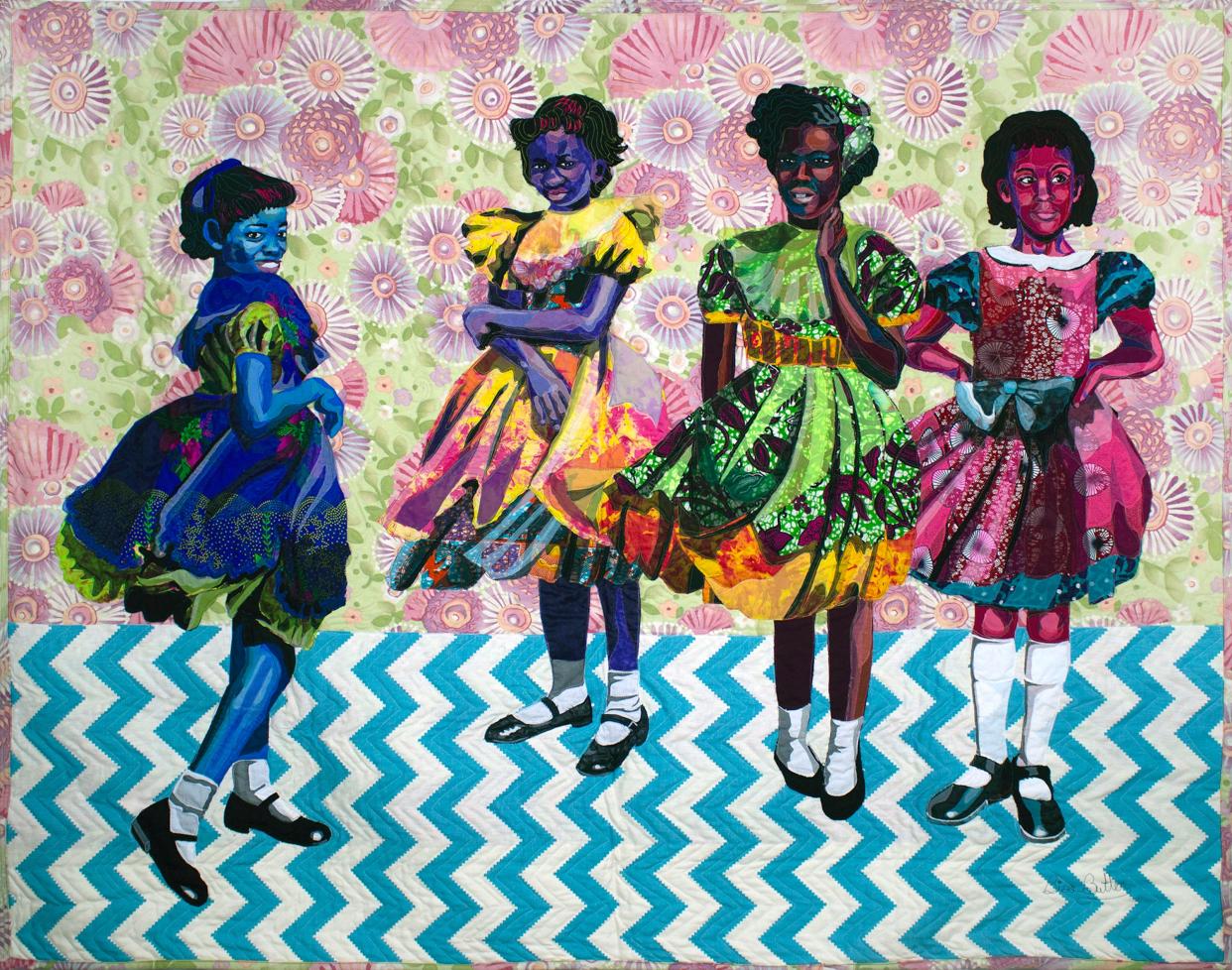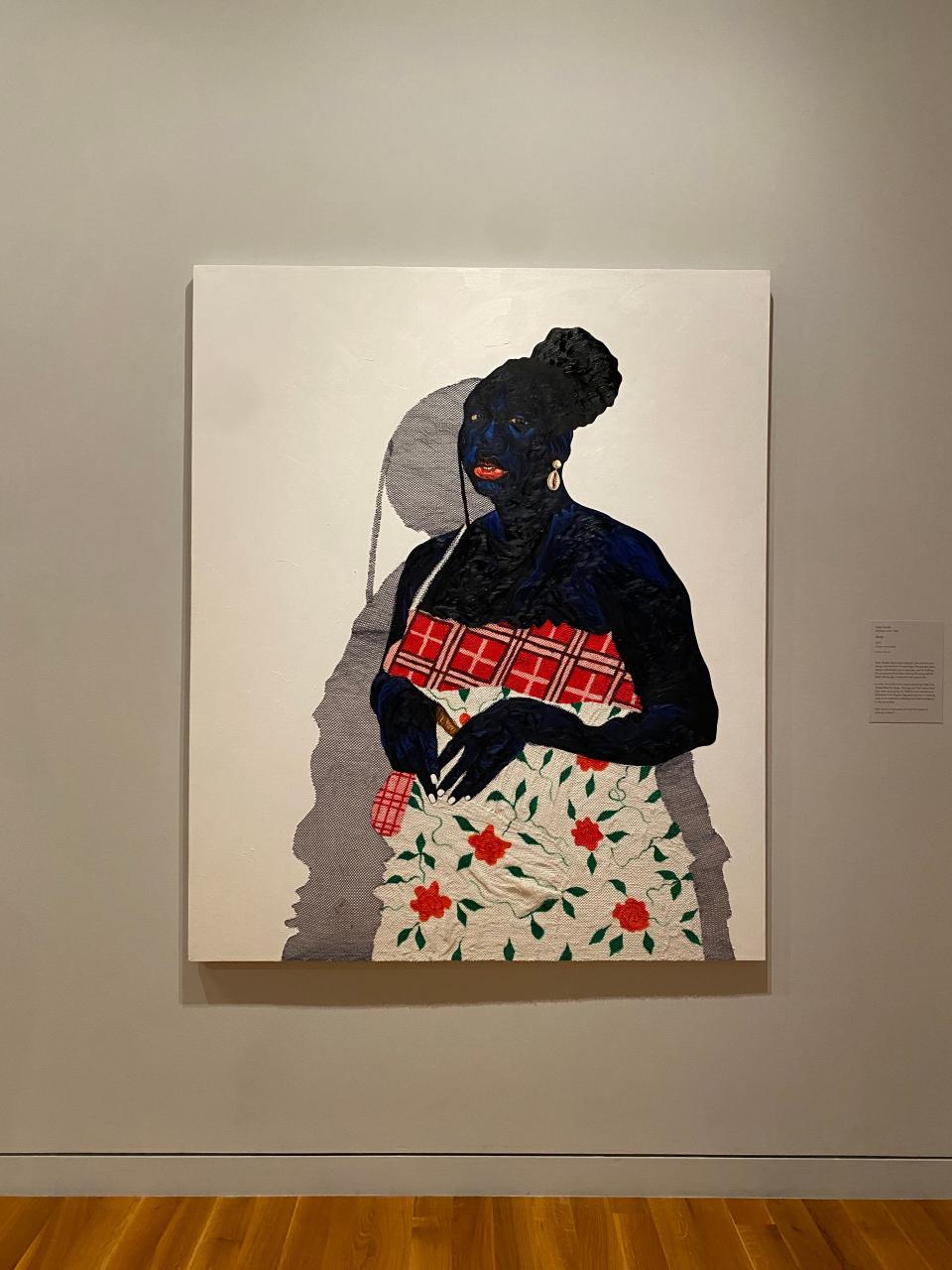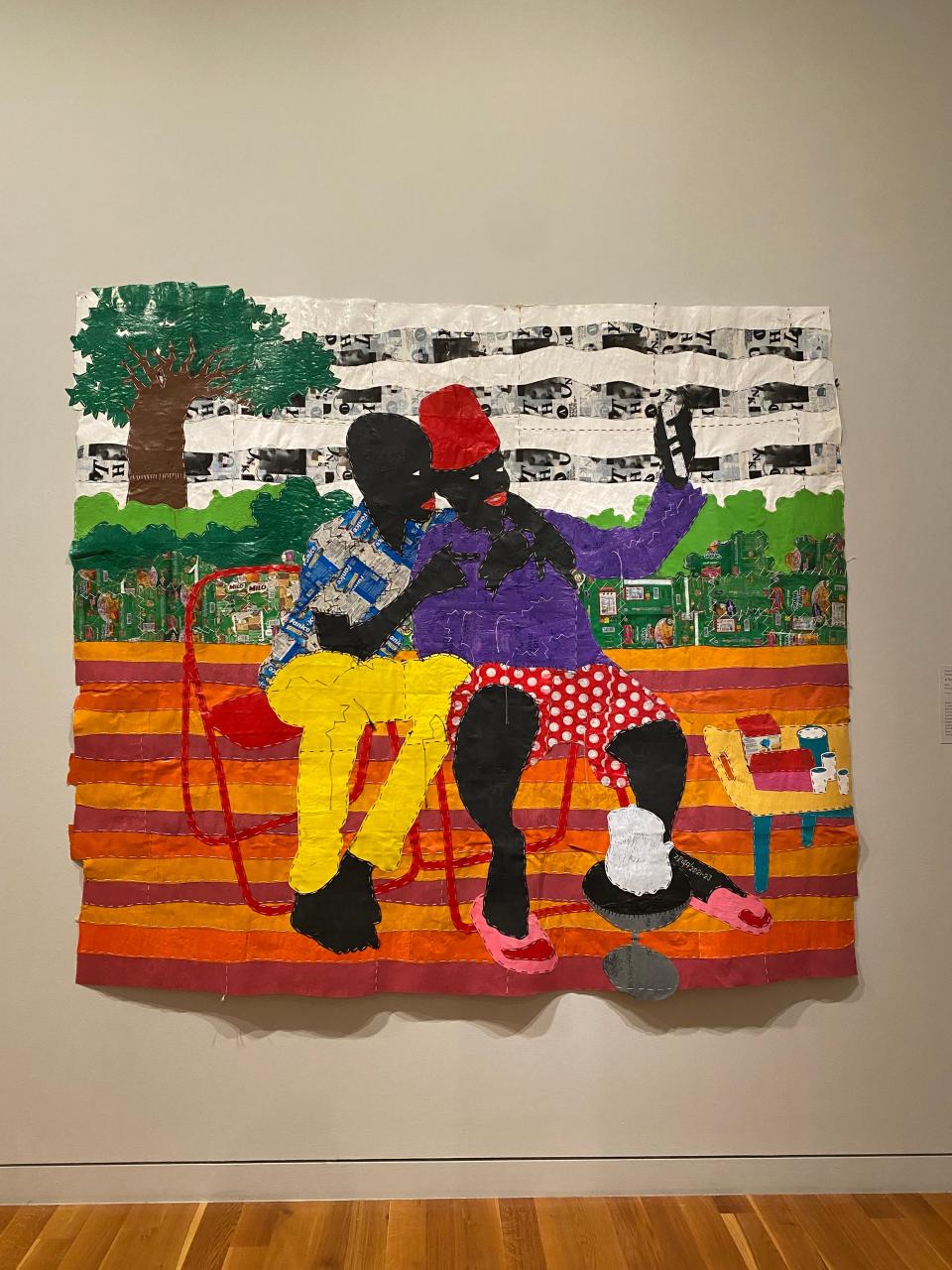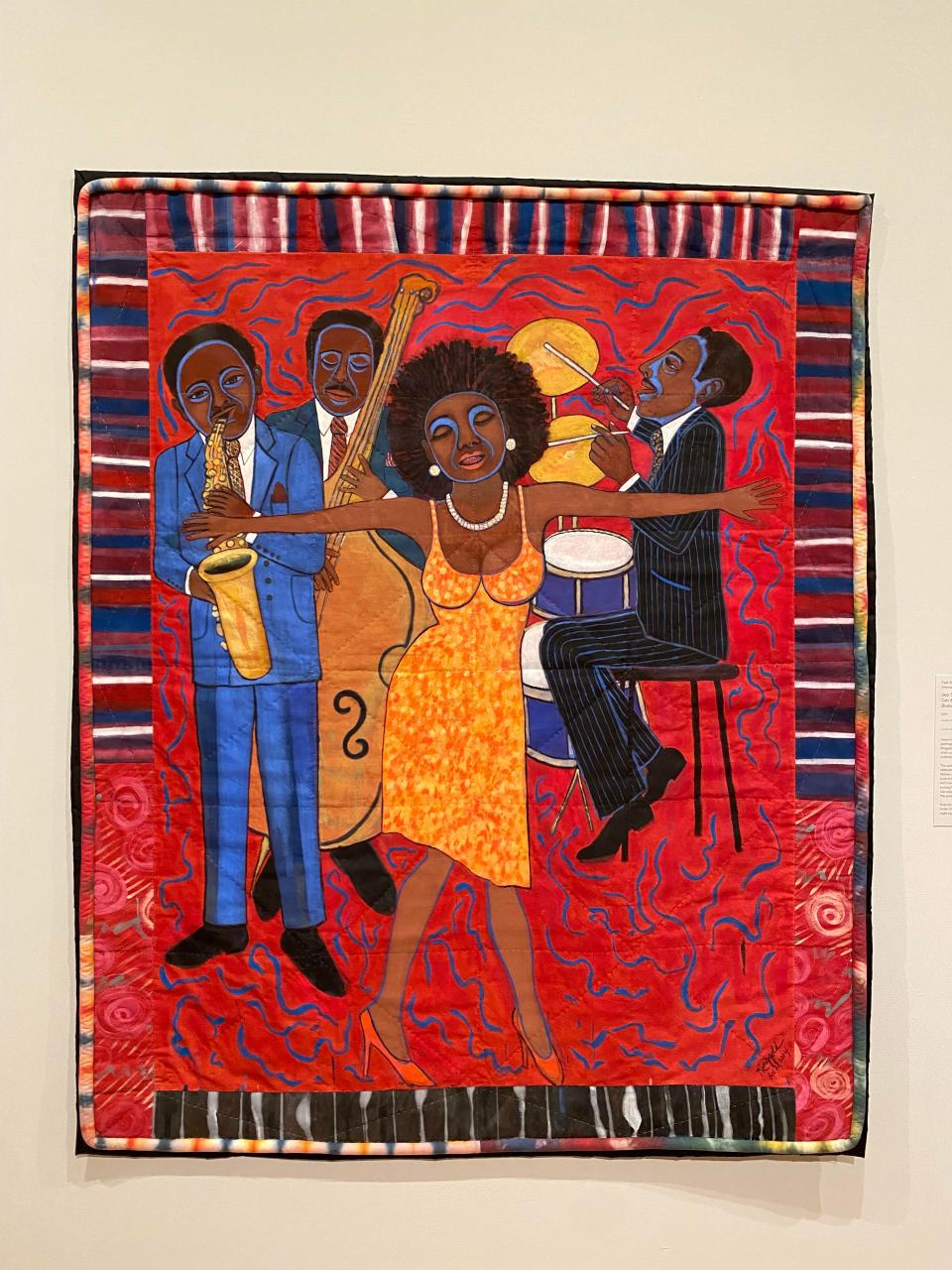Bold, spirited exhibits pay homage to Ghana and American quilting at Columbus Museum

- Oops!Something went wrong.Please try again later.
Bold African faces stare directly at viewers. They are painted and mixed media portraits of people from Ghana’s capital, Accra, a sister city to Columbus since 2015.
In the first Columbus Museum of Art exhibit devoted to Ghana artists, “Accra! The Rise of a Global Art Community” celebrates nearly 30 works by 18 contemporary, living artists from the West African country. Their art is inventive, often surprising and always spirted.
Entering the exhibit, viewers are immediately struck by eye-popping works.
Made entirely of cast-off metal, mostly beer caps, “Focus” by El Anatsui is a huge, abstract wall installation. With its glittering waves, it seems to soar toward the ceiling.
Also in this first section are two portraits by Amoako Boafo: “Sunset III,” an African bathing beauty in a white swimsuit, and “Green Shirt,” a man with mottled flesh tones created by thick swirls of paint.
More: 10 Black artists to see in the Columbus Museum of Art
The numerous portraits in the exhibit reflect a variety of skin tones, or as Deidre Hamlar, curator at large at the museum, put it, “the black skin evolves from picture to picture,” ranging from tones of pure black to blue-black, bronze and various combinations. Amoako Boafo’s “Finger’s Locked” shows how intriguingly black skin can be presented in varying colors and finger-painted strokes.
Kwesi Botchway, whose painting “We Are In This Together” uses faces in a mirror to look at viewers rather than directly facing them, spoke about portraiture before the opening of the exhibit. Coincidentally, he used the word “reflection.”
“In Ghana, when you say you are an artist, many people will ask, ‘Can you draw me?’’’ he said. “Portraiture is a reflection of ourselves that we can relate to … the purpose of my work is to elevate people.”

The adventurous approach to generous portraiture extends to materials.
Recycled plastic bags are used for the striking scene “A Pose for the Love of Attaya” by Rufai Zakari. He shows a couple sitting on folding chairs taking a selfie.
Patrick Quarm uses acrylic oil and mixed media to show a young brother and sister (“Nuanom”) lounging against a background of African print fabric and cut-out holes, creating shadows.
The matronly “Anita” wears a red, white and green gown crafted by artist Adjei Tawiah of sponges (kotsa), an everyday item used by Ghanaians to bathe the young, the old and the deceased.
At the conclusion of the exhibit is Gideon Appah’s “White Lines,” one of the few landscapes in the exhibit. The oil and acrylic work, said Hamlar, shows the dawn sun rising above the horizon, and a white ball of light casting its linear reflection across a calm lake.
“The work placed at the end of the exhibition signals a bright horizon lit by the evocative works of these artists, whose art brings us closer together,” she said.
“Accra!” was conceived and organized by curators Edmund Gaisie and Rebecca Ibel, working with Hamlar. It arrives after the city’s Ohio Ghana Fest, which took place in August.

More: Striking, contemporary 'Ohio Women to Watch' exhibit to visit multiple cities
'Quilts: Past and Present'
Co-existing with “Accra!” in the southern portion of the museum’s Walter Wing is an equally colorful exhibition of traditional and very untraditional quilts.
With many of the works drawn from the museum’s nearly 400-piece Wasserstrom Collection, quilts range from those made in such familiar old-time patterns as log cabin and double wedding ring to quilts made of comic book strips and faux quilts that are actually paintings of fabric.
Co-curated by Hamlar and the museum’s Roy Lichtenstein Curatorial Fellow, Sarah Berenz, the exhibit is divided in four sections, one devoted to patterns, another to quilted clothing, another to storytelling and the last to concerns about ecology and economy.
Most eye-catching are the narrative quilts including Wendy Kendrick’s “Queen Mother,” Faith Ringgold’s cabaret scene “Jazz Stories” and gorgeous black and white quilts by Ohioan Carolyn Mazloomi, also the juror of Quilt National ’23, a hugely innovative exhibition presented biennially by the Dairy Barn Art Center in Athens, Ohio. Mazloomi’s delightful “Sitting With a Few of My Best Friends” shows children reading books. Bisa Butler’s “Four Little Girls, September 15, 1963” remembers the victims of the Birmingham Baptist Church bombing.

Johnathan Payne’s comics quilt, constructed of miniscule woven snippets of comic strips, pays tribute to the Fantastic Four.
John Coltrane’s “A Love Supreme” album is referenced in Sedrick Huckaby’s enormous (7 ½ by 80 feet) painting. Without using actual fabrics, the work considers the impact of textile waste on the environment.
So, too, does Dawn Williams Boyd worry about ecology in her deep-sea quilt “35,812 Feet Below Sea Level: Challenger Deep.” Beneath the sea creatures in the vertical scene and almost hidden at the bottom is a discarded can of Coca Cola.
“Quilting a Future” pays homage to the traditional quilting practice, and points to the innovation of contemporary artists who think quite differently about the art form.
At a glance
“Accra! The Rise of a Global Art Community” and “Quilting a Future: Contemporary Quilts and American Tradition” continue through Jan. 28 at the Columbus Museum of Art, 480 E. Broad St. Hours: 10 a.m. to 5 p.m. Tuesdays through Sundays, until 9 p.m. Thursdays. Admission: Special exhibition admission of $8 plus regular admission of $18 adults; $9 children, students and senior citizens; $5 from 5-9 p.m. Thursdays. Regular admission on Sundays is free and always free for members, veterans and active military and their families. Call 614-221-6801 or visit columbusmuseum.org.
This article originally appeared on The Columbus Dispatch: New bold, colorful exhibits now on view at Columbus Museum

